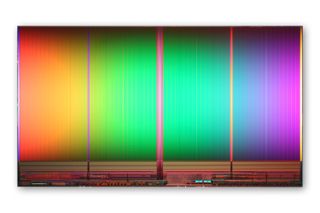Intel, Micron Introduce 25nm Flash Memory
Intel and Micron officially announced 25nm process technology.

Intel and Micron Technology announced today that a new era in storage, smartphones, and media players has begun with the introduction of 25-nanometer NAND technology. Not only is this the smallest process for NAND flash memory, but currently the smallest process for semiconductor technology in general. Who said bigger was better?
The joint venture between Intel and Micron will be manufactured by IM Flash Technologies. The 25nm process will cram a whopping 8 GB of storage on a single NAND chip. Intel's announcement today paints a pretty picture on the NAND's actual size: measuring just 167mm2, it's small enough to fit through the hole in the middle of a CD, but packs 10 times the data capacity of the disc.
With that said, manufacturers can cram more storage into their devices, or use the extra room to throw in a new feature. In any case, the number of chips to provide the same amount of storage space has been cut down to half the load. As an example, a 256 GB solid-state drive used 64 NAND chips now only requires 32. A 16 GB flash card now only need two chips, whereas a 32 GB smartphone now only needs four.
Tom Rampone, vice president and general manager, Intel NAND Solutions Group, said that the new 25nm processing should speed up the adaption of solid-state drives. "Through our continued investment in IMFT, we're delivering leadership technology and manufacturing that enable the most cost-effective and reliable NAND memory," he said.
Currently Intel is sampling the 25nm, 8 GB NAND, and plans to kick it into high gear with mass production in Q2 2010.
Stay on the Cutting Edge
Join the experts who read Tom's Hardware for the inside track on enthusiast PC tech news — and have for over 25 years. We'll send breaking news and in-depth reviews of CPUs, GPUs, AI, maker hardware and more straight to your inbox.
-
BoxBabaX I hope this is what we need to drive down prices of the current gen SSD's. I can only imagine the impact it will have on the new smart phones too, no more BS, give us 32gb on smartphones as standard!Reply -
burnley14 boxbabaxI hope this is what we need to drive down prices of the current gen SSD's. I can only imagine the impact it will have on the new smart phones too, no more BS, give us 32gb on smartphones as standard!Reply
That's exactly what I was thinking. Hooray for Intel and Micron! -
830hobbes I feel like its only fair to point out that there are fewer typos and grammatical errors on Tom's lately. Not that articles should be judged by those factors but since they seem to be here: good job lately, Tom's writers!Reply -
wayneepalmer I'm dreaming more about 128 GB SSD's that truly and comfortably (AND CHEAPLY) can be used as a boot drive.Reply -
eklipz330 Replyit's small enough to fit through the hole in the middle of a CD
That's what she said. -
bison88 If this creates a 50% drop in SSD's across the board who adopt the 25nm chips I will definitely consider upgrading my hard drives.Reply -
dafin0 on a different site (not sure if im allowed to post name) they said "Objective Analysis notes the manufacturing cost of the 25nm chips will be approximately $.50 per gigabyte. This is a substantial decrease from the estimated $1.75 per gigabyte cost of 45nm flash."Reply -
zachary k hello new flashdrive. i could use both the space, speed, and price improvement. now all i need is for USB 3.0 to go into mass circulation, but that wont happen for some time.Reply -
viewwin I have a feeling prices will not drop that fast for a few months after introduction. Way to much demand out there vs supply.Reply
Most Popular


